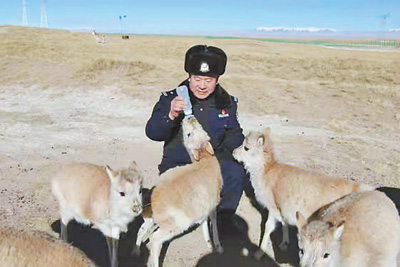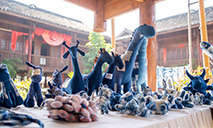Man devotes life to protecting Tibetan antelopes in the wildlife paradise of Hoh Xil
Police officer Zhao Xinlu has been patrolling the inhospitable Hoh Xil, an ideal habitat for endangered Tibetan antelopes and other wildlife such as Tibetan gazelles and wild yaks in northwest China’s Qinghai Province, for 25 years.

Police officer Zhao Xinlu feeds a baby Tibetan antelope with milk in Hoh Xil, northwest China’s Qinghai Province. (File photo)
Zhao has been working in the Hoh Xil, which rises to an average altitude of over 4,600 meters, since 1997 when the Hoh Xil National Nature Reserve was established. Back then, two of his main tasks were to catch poachers and to protect Tibetan antelopes. The Tibetan antelope population drastically dropped from over 200,000 to less than 20,000 due to rampant illegal hunting in the 1980s and 1990s.
When Zhao first arrived at the Sonam Dargye protection station, which was named after Sonam Dargye, a martyr who died protecting Tibetan antelopes, he experienced severe hypoxia and nosebleeds and even thought for a moment about turning back in retreat. However, when he saw that dozens of Tibetan antelopes were being hunted down during his first patrol task, he became immediately determined to protect the species.
Over the past years, Zhao and his colleagues have trekked more than 800,000 kilometers over the course of over 500 patrols conducted in Hoh Xil. They have captured 354 suspected poachers and lawbreakers, seized 21 guns and over 30,000 rounds of ammunition, having also confiscated 3,909 Tibetan antelope skins.
“Not one single shot has been fired by poachers in Hoh Xil for years,” Zhao remarked proudly.
Thanks to the efforts of Zhao and his team, the Tibetan antelope population in Hoh Xil has rebounded to a headcount of more than 70,000 now. Besides, the numbers of other rare and endangered species, such as snow leopards and Tibetan gazelles, have also increased continuously over the years. Hoh Xil has gained a reputation in the region as having the richest biodiversity on the Qinghai-Tibet Plateau.
“Going forward, we will improve the working and living conditions of workers at our protection station, as well as the level of protection for animals and plants,” Zhao said.
Photos
Related Stories
- Rangers provide vital nourishment to Tibetan antelopes during bout of heavy snow, low temperatures
- Wildlife in Hoh Xil, NW China
- Guardians of the Tibetan antelope
- Rescued Tibetan antelopes give birth to babies
- Rescued Tibetan antelopes released into the wild in Hoh Xil
- Tibetan antelope population reaches 300,000 to 400,000 in China
- Number of Tibetan antelopes exceeds 200,000 in Tibet
Copyright © 2022 People's Daily Online. All Rights Reserved.










